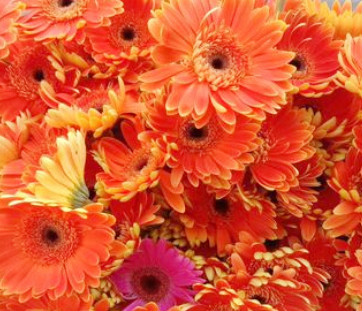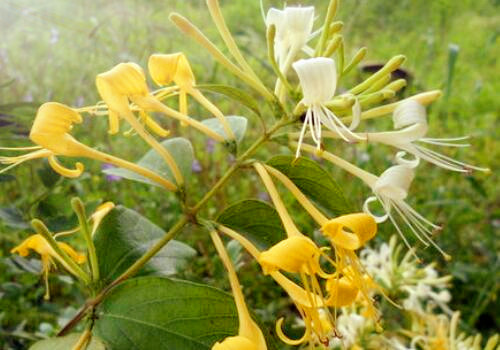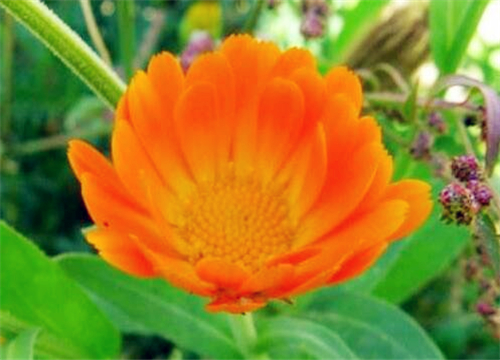Culture methods of African Chrysanthemum (Gerbera morifolium)
Speaking of African chrysanthemum, you may be a little strange, but in fact, African chrysanthemum is our common flower, there are also sunflowers and other names, it is colorful and dazzling, often used in home layout, the following editor will introduce to you the cultivation methods of African chrysanthemum:
I. A brief introduction to Gerbera
African chrysanthemum, Compositae, also known as Fulang flower, sunflower, gorilla chrysanthemum, sunflower, etc., are perennial herbs with terminal inflorescences, with red, white, yellow, orange, purple and so on. The method of sowing or planting is used for reproduction, and the country of origin is South Africa.
African chrysanthemum is a perennial perennial evergreen herb with about 45 species of the same genus. Warm in winter and cool in summer, well-ventilated, sunny environment, not cold-resistant, avoid hot. The sandy loam with loose fertility, good drainage and rich humus, avoid heavy clayey soil, is suitable for slightly acidic soil, and the optimum pH for growth is 6.0-7.0. The suitable temperature for growth is 20: 25 ℃, the optimum temperature in winter is 12: 15 ℃, and when it is lower than 10 ℃, it stops growing. It is a semi-cold-tolerant flower and can tolerate a short-term low temperature of 0 ℃. Plant height 30~45cm, leaves basal, petiole long, leaf blade oblong spoon-shaped, pinnately lobed or parted. Capitate inflorescences solitary, higher than foliar 20~40cm, flower diameter 10~12cm, involucral bracts discoid, bell-shaped, ligulate petals in double shape, flowers in bright red, orange-red, light red, yellow and so on. There are usually flowers in the four seasons, with the spring and autumn at their peak.
2. Culture methods of African chrysanthemum
1. Soil: gerbera is sensitive to water and should use a medium with good permeability and drainage, preferably a mixture of peat and perlite. The pH value is 5.5 to 6.0 and the EC value is 0.7 to 1.0, which is beneficial to the absorption of trace elements.
2. Watering: African chrysanthemum is very sensitive to water, so it must be watered at the right time, in the morning or evening, and make the plant relatively dry at night. When the plant begins to grow roots, it must be watered from the bottom, which can be infiltrated from the bottom. Water can be watered from above the plant during high temperature, but care should be taken to prevent fungal mildew from the center of the plant.

3. Sunshine: the most suitable sunshine length in the growth process of African chrysanthemum is 11 hours to 13 hours, so artificial light can be replenished in low light, and the general requirement of artificial light is 3500 to 4000 lux per square meter.
4. Temperature: the most suitable temperature for the growth of African chrysanthemum is between 15 ℃ and 25 ℃, the highest is not higher than 30 ℃ and the lowest is not less than 13 ℃. High temperature will affect the normal flower bud differentiation, and low temperature will cause plant death.
5. Fertilization: African chrysanthemum is a fertilizer-loving perennial flower, which has a large demand for fertilizer. the ratio of nitrogen, phosphorus and potassium is 15:18:25, once every 5-6 days and once every 10 days. If the plant is semi-dormant caused by high temperature or low temperature, fertilization will be stopped.
6. Diseases and insect pests: the diseases of African chrysanthemum include leaf spot, powdery mildew and virus. Leaf spot disease was sprayed with 70% methyl topiramate wettable powder 800-1000 times or 50% carbendazim wettable powder 500 times. Powdery mildew was controlled with 1500 times of thiophanate methyl or 1000-1200 times of 1000-1200 times of 70% thiophanate methyl, once every 7 days, two to three times in a row.
7. Pruning: the withering and senescence of the lower leaves of Gerbera gerbera basal leaves should be removed in time, which is not only conducive to the germination of new leaves and flower buds, but also conducive to ventilation and enhance plant growth. In addition, if the branches and leaves of the plant are too luxuriant to cover each other, some of the leaves can be removed properly.
Time: 2019-03-13 Click:
- Prev

Honeysuckle planting market prospect is good, flower and seedling price and technology should know!
With the popularity of traditional Chinese medicine and the importance of Chinese herbal medicine, many areas regard the cultivation of Chinese herbal medicine as a project to get rich, among which honeysuckle, which has a good market, is also one of the items of choice. But if you really want to grow honeysuckle, you should know the price and technology of the seedlings! Introduction of Honeysuckle
- Next

When is the best time to sow calendula? Explain the matters needing attention in planting calendula at 3 o'clock!
The leaves and petals of calendula are edible and are often used as the decoration of dishes, with the effect of clearing away heat and detoxification, promoting blood circulation and regulating menstruation. Many friends start planting when they see the value of calendula, but they don't know when to sow the seeds. Today, I will explain in detail the matters needing attention in the planting of calendula.
Related
- Fuxing push coffee new agricultural production and marketing class: lack of small-scale processing plants
- Jujube rice field leisure farm deep ploughing Yilan for five years to create a space for organic food and play
- Nongyu Farm-A trial of organic papaya for brave women with advanced technology
- Four points for attention in the prevention and control of diseases and insect pests of edible fungi
- How to add nutrient solution to Edible Fungi
- Is there any good way to control edible fungus mites?
- Open Inoculation Technology of Edible Fungi
- Is there any clever way to use fertilizer for edible fungus in winter?
- What agents are used to kill the pathogens of edible fungi in the mushroom shed?
- Rapid drying of Edible Fungi

